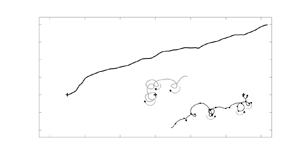No CrossRef data available.
Article contents
Unique stochastic Lagrangian particle dispersion models for inhomogeneous turbulent flows
Published online by Cambridge University Press: 30 September 2021
Abstract

It is well established that Lagrangian particle dispersion models, for inhomogeneous turbulent flows, must satisfy the ‘well-mixed condition’ of Thomson (J. Fluid Mech., vol. 180, 1987, pp. 529–556) in order to produce physically reasonable results. In more than one dimension, however, the well-mixed condition is not sufficient to define the dispersion model uniquely. The non-uniqueness, which is related to the rotational degrees of freedom of particle trajectories, permits models with trajectory curvatures and velocity autocorrelation functions which are clearly unphysical. A spin condition is therefore introduced to constrain the models. It requires an ensemble of particles with fixed initial position and velocity to have, at short times, expected angular momentum, measured relative to the mean position and velocity of an ensemble of fluid particles with initially random velocity, equal to the relative angular momentum of the mean flow at the ensemble mean location. The resulting unique model is found explicitly for the canonical example of inhomogeneous Gaussian turbulence and is characterised by accelerations which are exponential in the particle velocity. A simpler unique model with a quadratic acceleration is obtained using a weaker version of the spin condition. Unlike previous models, the unique models defined by the spin condition lead to particles having the correct (ensemble mean) angular speed in a turbulent flow in solid-body rotation. The properties of the new models are discussed in the settings of a turbulent channel flow and an idealised turbulent atmospheric boundary-layer flow.
JFM classification
- Type
- JFM Papers
- Information
- Copyright
- © The Author(s), 2021. Published by Cambridge University Press





